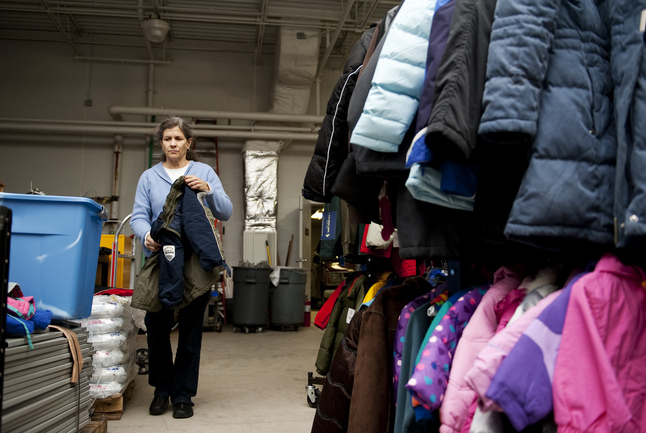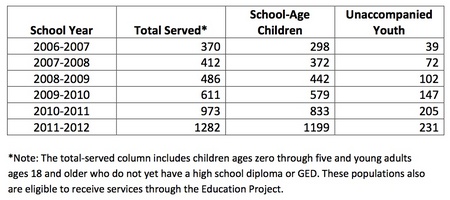
Volunteer Sue Abbott sorts, organizes and sizes winter coats at the Washtenaw Intermediate School District for the Education Project for Homeless Youth. Abbott originally started with a two-hour shift, now she’s coming back on a regular basis. "It's a real good group that works incredibly hard," she says. Dozens of volunteers help the organization throughout the year.
Daniel Brenner I AnnArbor.com
Coming Monday: Washtenaw County schools adjust to serve, transport growing number of homeless students
Homelessness among Washtenaw County youth and families is on the rise, and the increase has caused the county’s primary organization for aiding homeless students to rethink how it operates.
Between the 2010-11 and 2011-12 academic years, the Education Project for Homeless Youth (EPHY) saw the total number of students it served increase by nearly 32 percent, from 973 students to 1,282.
Jennifer Martin, program manager for the Education Project, said judging by the pace of referrals for the current school year, the organization is again on track to surpass last year’s total.
“We’re already at almost 900 students identified and it’s only December,” she said. “Ideally, the numbers would start to taper off. But that’s not been the pattern of the past few years
“Every year, we think this has to be the peak. But the need keeps growing.”
The Education Project is a federally funded program through the Washtenaw Intermediate School District. It receives grant money from the McKinney-Vento Homeless Assistance Act, which was reauthorized in January 2002.
The act was created to ensure all youth, including homeless or transitional youth, have equal access to a free and stable public education.
McKinney-Vento defines homeless children as “individuals who lack a fixed, regular and adequate nighttime residence.”
While the number of homeless youth in Washtenaw County has increased, the number of single homeless adults decreased by 7 percent from 2009 to 2011, according to a recent data report prepared by the Washtenaw Housing Alliance.
The Education Project began helping homeless youth in 2006-07. During its first year, it served 370 students. The first real spike of children served occurred in 2009-10: 611 students, from 486 the year before.
Despite the growth in homeless students, the Education Project’s funding appears to have leveled off, said Zoe Starkweather, who is in charge of grants and development for EPHY. The program’s staff structure also has remained about the same since 2006, she said.
The Education Project received $66,738 this year, and $60,000 of that went directly into staffing, Starkweather said.
“People need people to help them navigate the system,” she said.

The project employs three part-time social workers. Martin is the closest to full time at 32 hours, Starkweather and Education Coordinator Erin Schaffer work 20 hours per week. EPHY also relies on the assistance of unpaid interns from the University of Michigan and a host of retired teachers and other community volunteers.
The Education Project serves as the coordinator of services for homeless youth in the county. And at its onset, the program’s model was set up much like a case management model. But Martin said due to the increased volume and the level of intensity in the services EPHY provides, the staff has had a number discussions recently about how to streamline its efforts and become more specialized.
“Because there are so few of us here, our focus really is shifting and responsibility is falling more on the school to make sure the day-to-day needs of families are being met,” Martin said.
She said in the past, families that were identified as homeless were referred to the Education Project. EPHY would assist families with filling out the appropriate paperwork and once immediate needs were identified, the project would provide clothing or food or housing resources.
“With the sheer volume, it just doesn’t make sense for us to do that anymore,” Martin said. “We used to deliver backpacks to families, now we just give them to the schools because they know who needs them best anyway
“We have to re-examine our model. And right now we don’t know exactly what that is going to look like as we specialize more.”
Starkweather said the key will be perfecting the central agency piece and taking on more of an oversight role. She said there is no reason the Education Project should process all of the paperwork for families. Also, preventing duplication of services in the county is important.
“The other agencies, in the mid-90s to early 2000s, were not as extensive as they are these days. So we were doing more clothing and food,” Starkweather said.
In the past, the Education Project collected jeans to give to homeless families. However, Martin said the project didn’t have room for them anymore. Now, the project gives its jeans to the House by the Side of the Road, located at 824 Phoenix in Ann Arbor. The House by the Side of the Road has the setup to facilitate this service and families still can receive free jeans via a referral from the Education Project, Martin said.
Additionally, the Education Project no longer stocks its own pantry but has partnered with Food Gatherers to provide food for homeless families.
It is not clear why the number of homeless youth is on the rise in Washtenaw County, and people who work with the homeless have a variety of theories. But mostly, experts believe it is a combination of factors.
Ellen Schulmeister, executive director for the Shelter Association of Washtenaw County, said it is partly because there is not enough affordable housing in the area.
“The only way to get more is for the community to actually invest in it. And that money has to come from the state and the feds, but also locally. We have to be willing to make this issue a priority,” she said.
She added public housing units are expensive to build, and the rent is cheap and often unreliable. So instead, developers are investing in student high-rises and luxury apartments, Schulmeister said.
She said the only benefit to this is the student-housing boom could eventually free up some of the private homes in the Ann Arbor city limits that have been “cut up” into apartments.
“Later down the road, it’s possible these homes could be turned into affordable housing or temporary housing for families and people in need,” Schulmeister said.
Single women with children account for 56 percent of all homeless families in Washtenaw County, according to the Housing Alliance. Schulmeister said it’s harder for these women — more so than any other demographic — to find a one-bedroom or studio apartment in this area that they can afford, due to the mouths they also have to feed.
She added the Department of Human Services recently began enforcing a four-year sanction on aid for single-parent households, which also may be contributing to the increase in homeless students.
DHS provides income for women with children who are not working, but there is a four-year limit on receiving that money and the mother can be cut off if she is not involved in an assistance program or actively trying to get a job, Schulmeister said.
From Martin’s vantage point of working with homeless youth, she sees the poor economy and job market as still being a major factor. She said the schools also are getting better at identifying homeless students, and the community as a whole has become more aware of the problem and the services available.

Katie Heumann, 9, of Ann Arbor, asked her friends to bring donations for the Education Project for Homeless Youth to her birthday party recently.
Courtesy of the Washtenaw Intermediate School District
Food, clothing, school supplies, winter coats and boots, money for homeless students to go on field trips and a variety of other donations are how EPHY best aids children.
“We really rely on the community a lot for those types of things. And we work with such amazing people,” Martin said.
This year, Keith Hafner’s Karate organized a huge fundraiser for the Education Project, raising more then $12,000. The karate students conducted a demonstration at Briarwood Mall and solicited corporate donors, as well as their family and friends, for funds, Martin said.
The project conducted a holiday gift drive for homeless students the week of Dec. 10 and was warmly given a wide array of toys and games from 9-year-old Ann Arbor resident Katie Heumann. For her birthday party, instead of bringing gifts for her, Katie asked her friends to bring gifts to donate to the Education Project.
“It was very touching,” said Emma Jackson, communications director for the WISD.
“The community always steps up,” Starkweather said.
Danielle Arndt covers K-12 education for AnnArbor.com. Follow her on Twitter @DanielleArndt or email her at daniellearndt@annarbor.com.